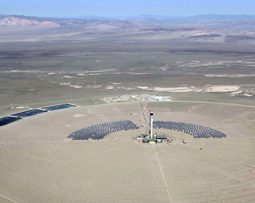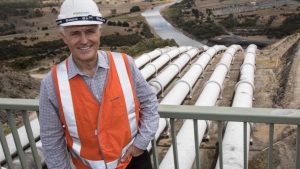The 110MW Crescent Dunes Solar Energy Plant, a concentrated solar power project due to be completed in Nevada early next year, will not just be the largest solar power tower plant with fully integrated energy storage built – it could also challenge the way the world thinks about renewable energy. Or even energy sources in general.
The $1 billion Crescent Dunes project near Tonopah in the Central Nevada Desert, some 300kms north of Las Vegas, was developed by the Santa Monica-based SolarReserve and features the company’s market leading molten salt power tower technology with fully integrated energy storage.
 What makes it unique and a potential game changer in the electricity industry is the flexibility and dispatchability of its power, meaning that it can deliver electricity whenever it is needed by customers; and its cost, which already beats diesel, is competitive with new build coal and gas generation.
What makes it unique and a potential game changer in the electricity industry is the flexibility and dispatchability of its power, meaning that it can deliver electricity whenever it is needed by customers; and its cost, which already beats diesel, is competitive with new build coal and gas generation.
The Crescent Dunes facility will have 10 hours of molten salt storage, which on average will allow it to deliver 110MW of baseload capacity to Las Vegas between the hours of 12 noon and midnight each day, when the city needs it most to power the lights and air conditioning of its casinos and entertainment palaces. It has signed a 25-year power contract with NV Energy, Nevada’s largest utility, to do that.
Tom Georgis, SolarReserve’s senior vice president of development, says the unique capabilities of the technology means that the plant could have been configured in any number of ways. With a 180MW turbine, for instance, it could have produced power for 10 hours each day, which was the original intention. With a smaller turbine, and more than 20 hours storage, it could have delivered 50MW of base-load power 24/7.
In the end, Nevada pitched for midday to midnight to suit its needs. In effect, the plant is providing baseload power for a fixed period each day – delivering the benefits of coal-fired power without the downsides, which is of course heavy pollution and an ability to be switched off at will or at regular intervals.
‘You can’t do that with a coal fired facility,” Georgis says of the Nevada contract. But the technology also allows it to compete with gas-fired generation, both in the ability to provide baseload and as a peaking plant.
Next year, SolarReserve begins construction of the 150MW Rice Solar Energy Plant in Southern California, which will act more like a peaking power station to suit that state’s needs. Proposals the company will take to Chile, Australia and the Middle East will likely be for baseload power. (We will explain more about those plans in the next two days).
“This should be the winning technology. It has all the attributes you looking for to displace conventional generation,” Georgis says. “It’s not just fulfilling renewable energy targets, you are displacing any new build fossil plants – from nuclear, gas and coal. This is going to change the discussion in energy markets, certainly around the idea that renewables are variable.”
Georgis says there is a lot of confusion about storage and what it means. He says the way to think about it is in the amount of electricity produced by a solar tower plant over a year.
With the standard “S-Class” configuration of the plant, the design being built at Tonopah, the plant can produce over 500GWh of electricity a year in strong solar locations such as Western Australia and the Southwest USA. That can be sliced and diced whichever way a customer – be it a utility, industrial group or a miner – chooses. And that can be in 24/7 base-load, delivering electricity at specific times of the day as in Nevada, or as a peaking plant.
“We are not just a renewable energy generator, we can integrate and help firm and shape other variable energy sources,” Georgis says. ”It will run in summer for 16-18 hours a day. But I can turn down the turbine and run it 24/7 if the utility asks me to do so.“
To emphasise the point, Georgis points to the following graphics that show the output from a solar PV plant, and a solar tower plant without storage. The big square blocks – coloured green and yellow – are two output scenarios from the tower with storage, but it can be reshaped and timed to suit the customer’s needs. Grid operators and many customers like big square blocks.
See our explainer to see more about how the technology works.
The other key point, and this is the critical one, is in price.
The Nevada project has a publicly disclosed power purchase agreement of $US135/MWh with NV Energy. The project is supported by cheaper finance from the Department of Energy Loan Guarantee Program, and tax incentives, but Georgis says it is also the first of its kind to be built at this scale and has extra margins and contingencies typical of a first plant.
For this reason, Georgis says $135/MWh should be viewed as a reasonable estimate of costs, because by the time the fourth or fifth plant has been constructed, the capital costs will have come down dramatically.
Georgis says that even without incentives, the LCOE would be “well south” of $200/MWh. In Chile, where the excellent solar resources means that the output is 40 per cent greater (around 700GWh a year), the price is already at $135/MWh without any incentives.
“By 2020, we should be south of $100/MWh (in the US, Australia and elsewhere) and not reliant on any type of government subsidy or incentive program”, he says. That is key, because as Bloomberg New Energy Finance noted, new coal fired and gas fired plants are already more expensive, and will be well north of that figure by 2020.
And Georgis says the generation facility can participate in any kind of energy market. “If you have a flexible dispatch market, a storage market, or a capacity market, it can participate in all of those. It can even play in the merchant market with a robust price,” he says.
 The Crescent Dunes plant will not be the first of its type, but it will be the biggest to date, and the first built to what Georgis describes as “utility scale”. The 18MW Gemasolar plant (pictured) has been operating in Spain for the last 18 months, and the 10MW Solar Two demonstration facility near Barstow in California’s Mojave Desert was operated by the Department of Energy in the 1990s.
The Crescent Dunes plant will not be the first of its type, but it will be the biggest to date, and the first built to what Georgis describes as “utility scale”. The 18MW Gemasolar plant (pictured) has been operating in Spain for the last 18 months, and the 10MW Solar Two demonstration facility near Barstow in California’s Mojave Desert was operated by the Department of Energy in the 1990s.
SolarReserve has the exclusive worldwide license to the technology which was developed by Rocketdyne, a subsidiary of Aerojet, and perfected during various space programs. These include the algorithms for the solar trackers that move the heliostats, and the receiver, which uses proprietary metallurgy technology that allows it to expand and contract, and to resist melting.
The company currently has 7 projects in various stages of development the US, two of which have power purchase agreements (Crescent Dunes and Rice), and six projects in Spain, including one (the 50MW Cinco Casas project) with a PPA, although the Spanish projects are not progressing at the moment because financing is difficult to obtain in the current market. SolarReserve is pursuing contracts in Chile, South Africa, North Africa, the Middle East, China and Australia.
(Tomorrow, SolarReserve talks about its plans for Australia).








